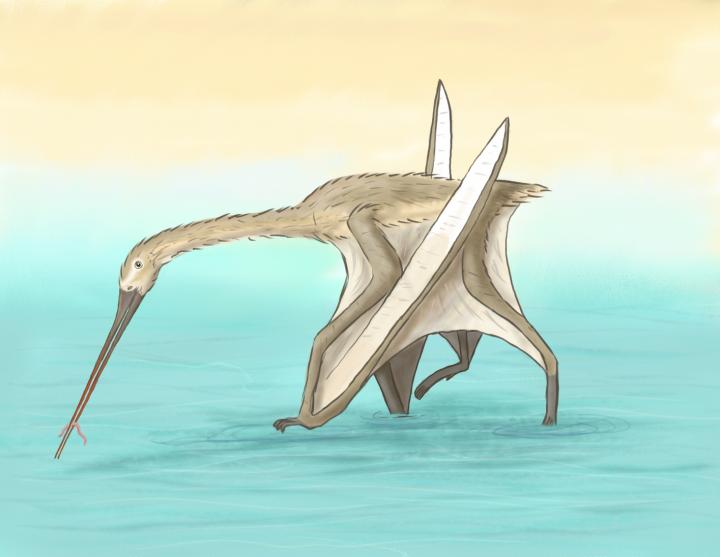
Credit: Megan Jacobs, University of Portsmouth
A new species of small pterosaur – similar in size to a turkey – has been discovered, which is unlike any other pterosaur seen before due to its long slender toothless beak.
The fossilised piece of beak was a surprising find and was initially assumed to be part of the fin spine of a fish, but a team of palaeontologists from the universities of Portsmouth and Bath spotted the unusual texture of the bone – seen only in pterosaurs – and realised it was a piece of beak.
Professor David Martill of the University of Portsmouth, who co-authored the study, said: “We’ve never seen anything like this little pterosaur before. The bizarre shape of the beak was so unique, at first the fossils weren’t recognised as a pterosaur.”
Careful searching of the late Cretaceous Kem Kem strata of Morocco, where this particular bone was found, revealed additional fossils of the animal, which led to the team concluding it was a new species with a long, skinny beak, like that of a Kiwi.
Lead author of the project, University of Portsmouth PhD student Roy Smith, said: “Just imagine how delighted I was, while on field work in Morocco, to discover the lower jaw to match the upper jaw found by Dr Longrich of this utterly unique fossil animal.”
The new species, Leptostomia begaaensis, used its beak to probe dirt and mud for hidden prey, hunting like present-day sandpipers or kiwis to find worms, crustaceans, and perhaps even small hard-shelled clams.
Pterosaurs are the less well-known cousins of dinosaurs. Over 100 species of these winged-reptiles are known, some as large as a fighter jet and others as small as a sparrow.
Professor Martill said: “The diets and hunting strategies of pterosaurs were diverse – they likely ate meat, fish and insects. The giant 500-pound pterosaurs probably ate whatever they wanted.
“Some species hunted food on the wing, others stalked their prey on the ground. Now, the fragments of this remarkable little pterosaur show a lifestyle previously unknown for pterosaurs.”
The scientists used a computerised tomography (CT) scan to reveal an incredible network of internal canals for nerves that helped detect the prey underground.
Dr Nick Longrich, from the Milner Centre for Evolution at the University of Bath, said: “Leptostomia may actually have been a fairly common pterosaur, but it’s so strange – people have probably been finding bits of this beast for years, but we didn’t know what they were until now.”
Long, slender beaks evolved in many modern birds. Those most similar to Leptostomia are probing birds – like sandpipers, kiwis, curlews, ibises and hoopoes. Some of these birds forage in earth for earthworms while others forage along beaches and tidal flats, feeding on bristle worms, fiddler crabs, and small clams.
Leptostomia could probably have done either, but its presence in the Cretaceous age Kem Kem strata of Africa – representing a rich ecosystem of rivers and estuaries – suggests it was drawn there to feed on aquatic prey.
“You might think of the pterosaur as imitating the strategy used successfully by modern birds, but it was the pterosaur that got there first,” said Dr Longrich. “Birds just reinvented what pterosaurs had already done tens of millions of years earlier.”
Dr Longrich suggests the new species shows how, more than a century after pterosaurs were first discovered, there’s still so much to learn about them. He said: “We’re underestimating pterosaur diversity because the fossil record gives us a biased picture.
“Pterosaur fossils typically preserve in watery settings – seas, lakes, and lagoons – because water carries sediments to bury bones. Pterosaurs flying over water to hunt for fish tend to fall in and die, so they’re common as fossils. Pterosaurs hunting along the margins of the water will preserve more rarely, and many from inland habitats may never preserve as fossils at all.
“There’s a similar pattern in birds. If all we had of birds was their fossils, we’d probably think that birds were mostly aquatic things like penguins, puffins, ducks and albatrosses. Even though they’re a minority of the species, their fossil record is a lot better than for land birds like hummingbirds, hawks, and ostriches.”
Over time, more and more species of pterosaurs with diverse lifestyles have been discovered. That trend, the new pterosaur suggests, is likely to continue.
###
The paper was published today in Cretaceous Research.
Media Contact
Sophie Wagstaff
[email protected]
Original Source
https:/
Related Journal Article
http://dx.




